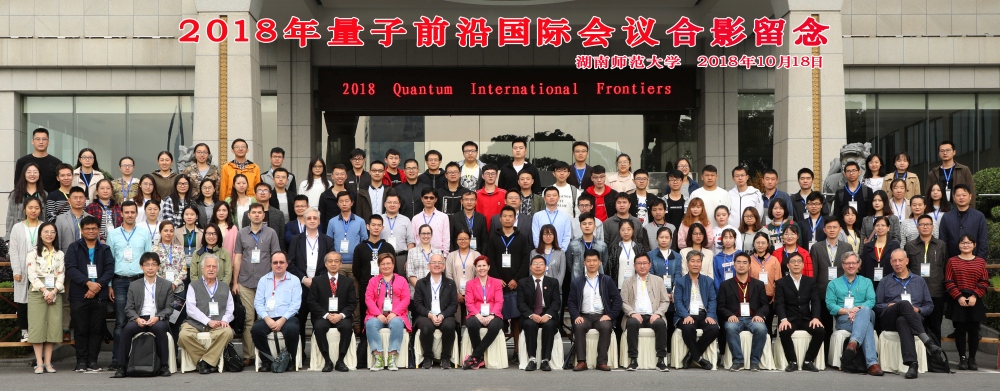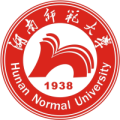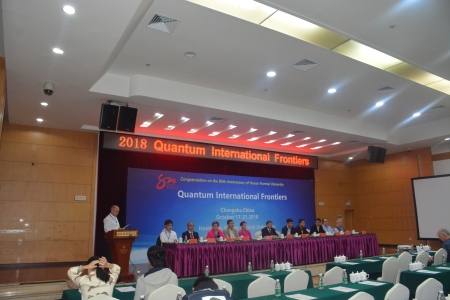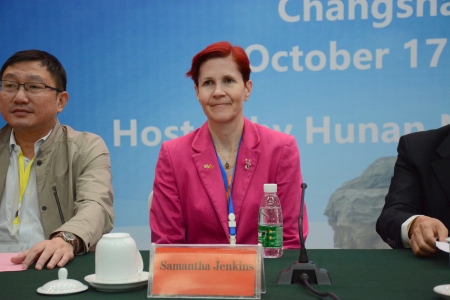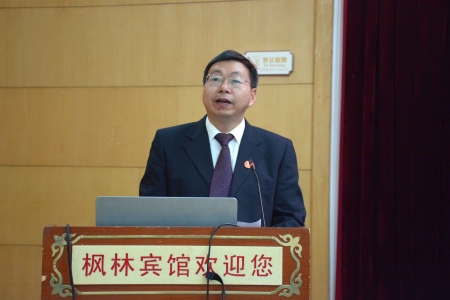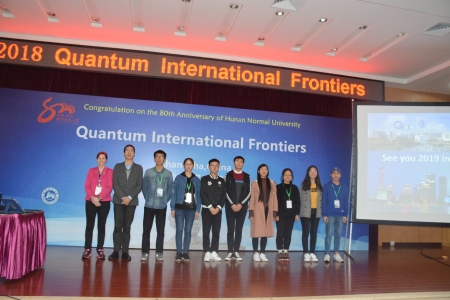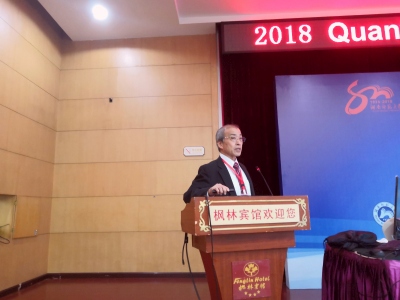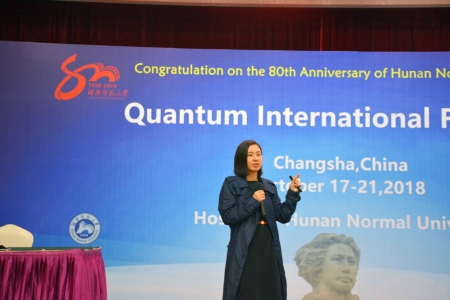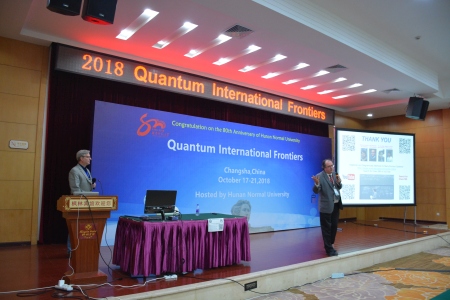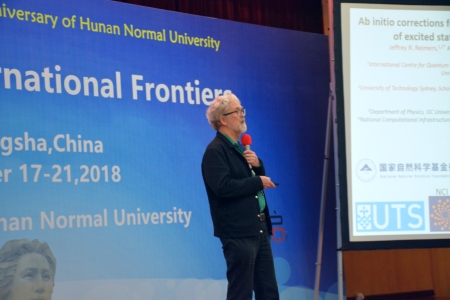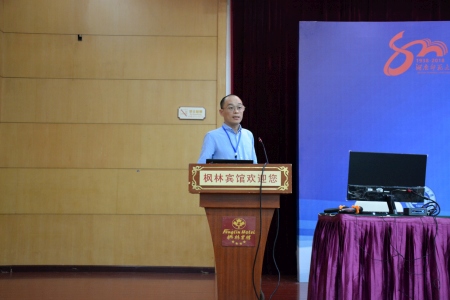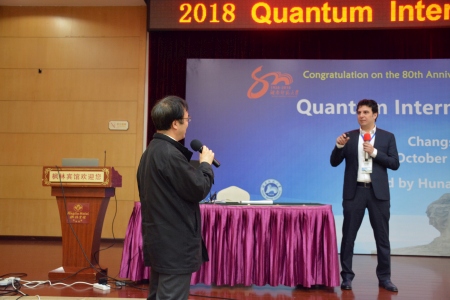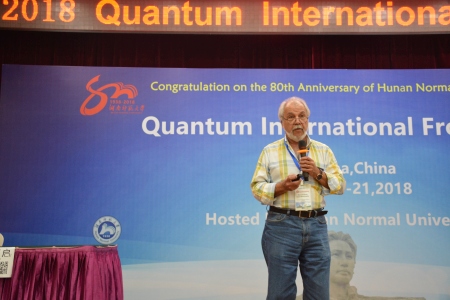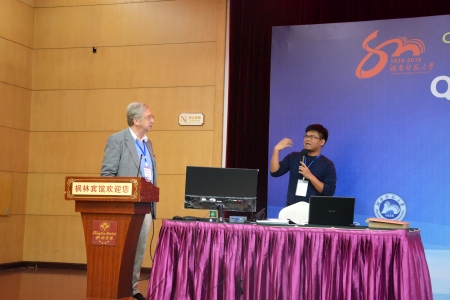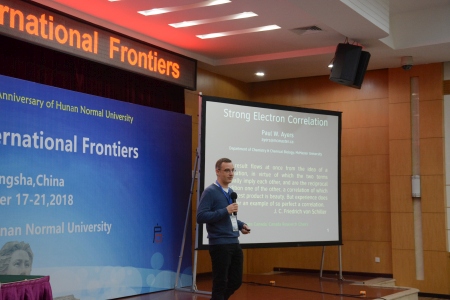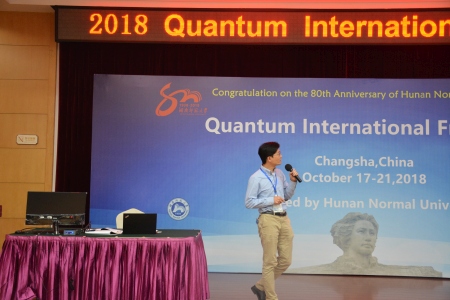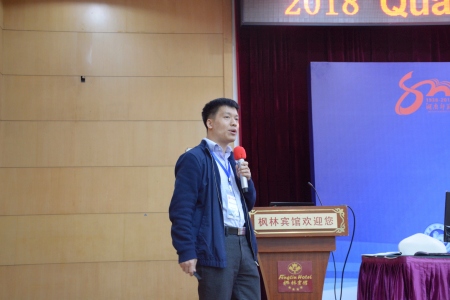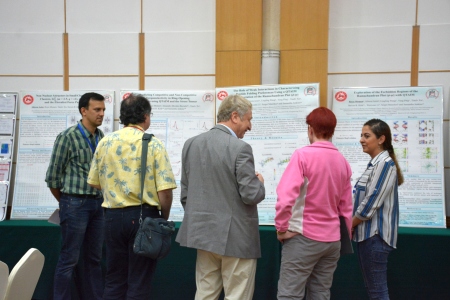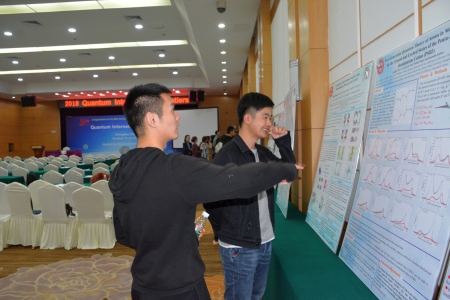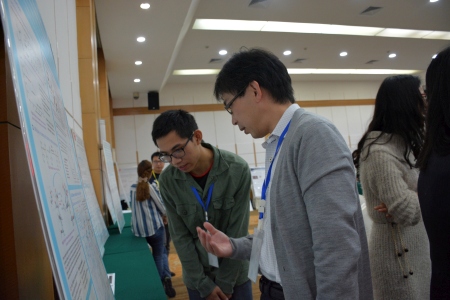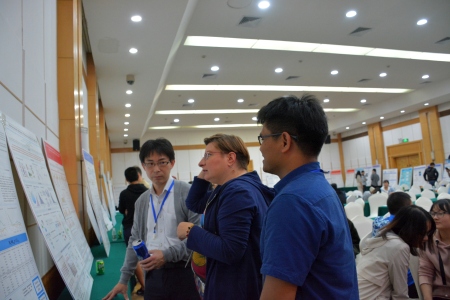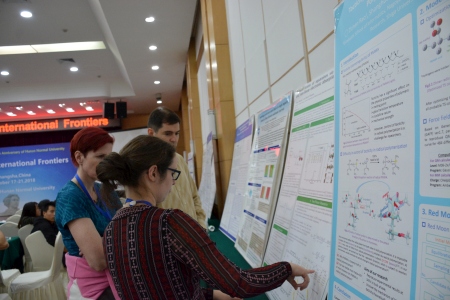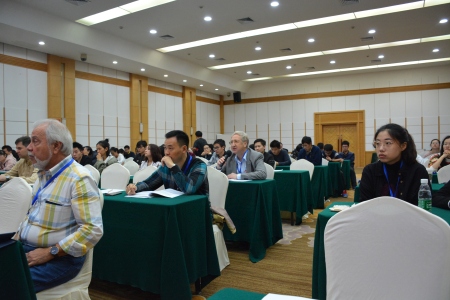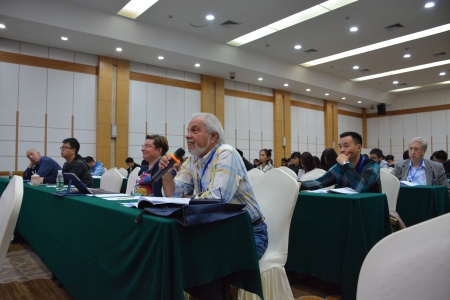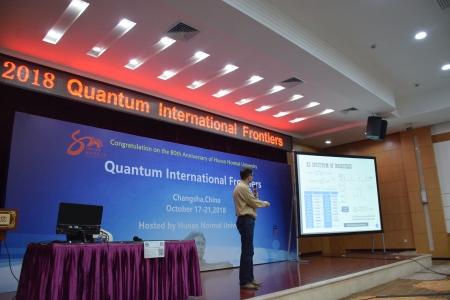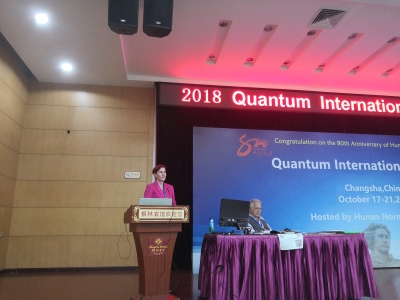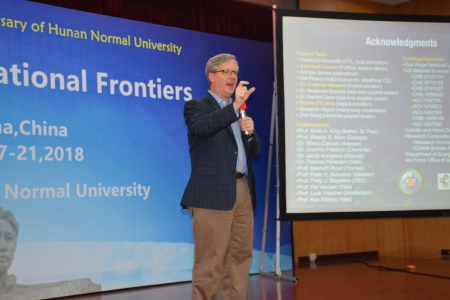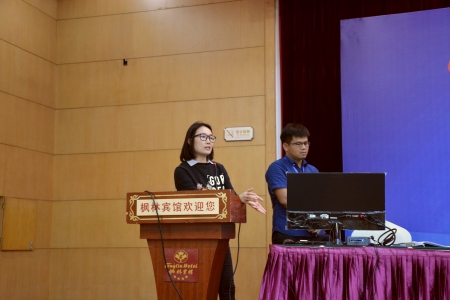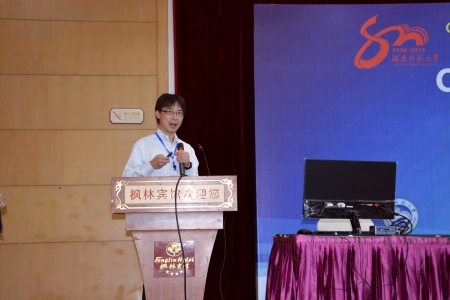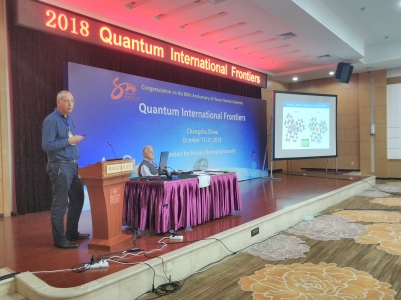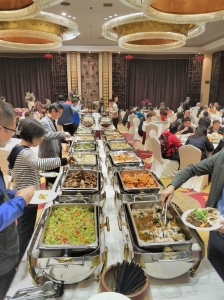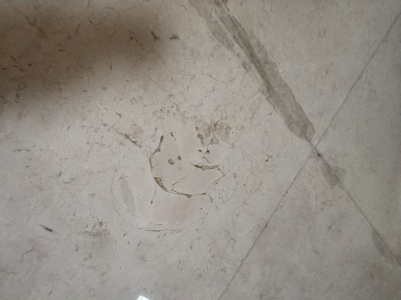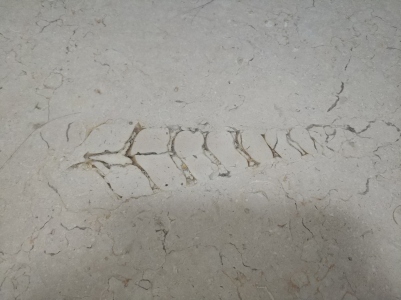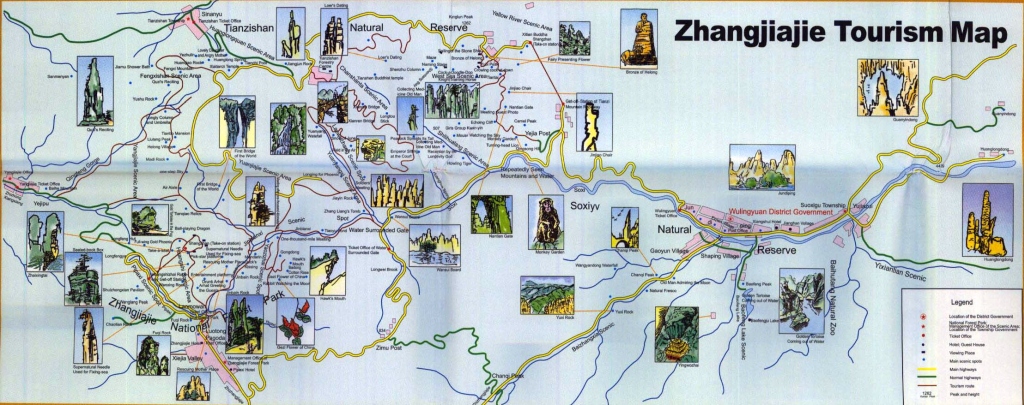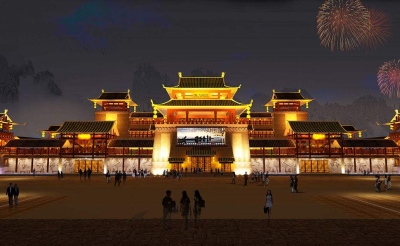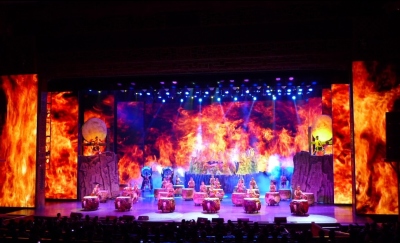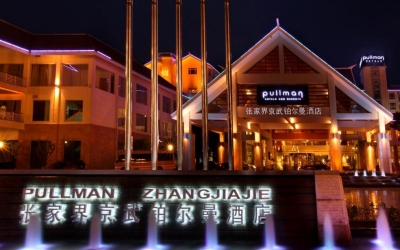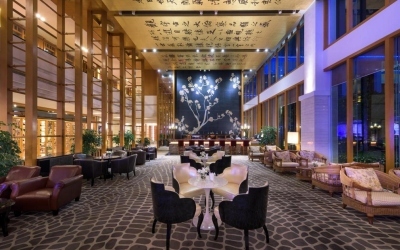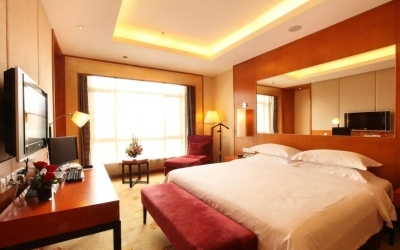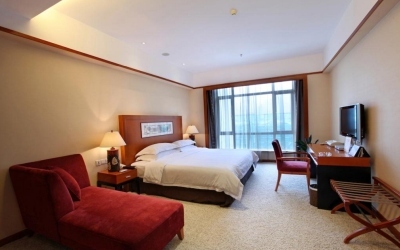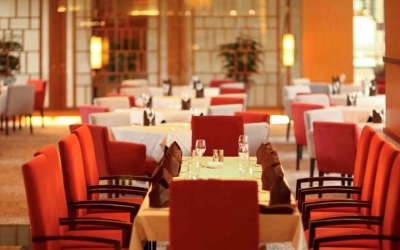Quantum International Frontiers 2018, October 17-21 2018,
Changsha, Hunan Province, P.R. China.
The Quantum International Frontiers 2018 conference has now concluded. Quantum International Frontiers 2019 will be held at the International Center for Quantum and Molecular Structures (ICQMS), Shanghai University, Shanghai, P.R. China.
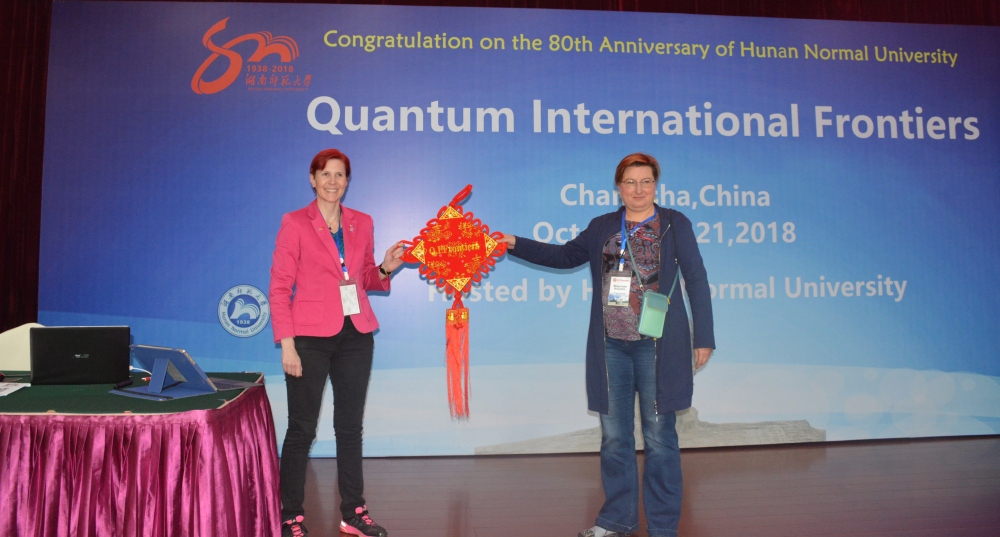
About Quantum International Frontiers 2018
Quantum International Frontiers 2018 will include sessions on:
- Quantum Modelling for Energy Conversion and Storage
- Relativistic Effects for Quantum Chemistry
- Spectroscopy, Molecular Structure and Dynamics
- Plasmas and Particles in Chemistry and Physics
- Catalysis, Reactive Collisions and Chemical Reactions
- Surfaces and Interfaces of Complexes and Clusters
- Molecular and Nano-materials for Electronics
- Quantum Effects and Applications
- Atoms and Molecules in Strong Fields
- Developments in Theoretical Concepts in Quantum Chemistry
Traditional and non-traditional lecture formats will be implemented in this conference.
- Invited lecture: 30 minutes (25 minutes talk, 5 minutes for questions)
- Lucas Visscher: Implementation and Applications of Relativistic Coupled Cluster Theory
- Jeffrey R. Reimers: Ab initio corrections for density-functional theory energies of excited states of defects in 2D materials
- Samantha Jenkins: Next Generation QTAIM
- Sergei Manzhos: Rectangular collocation for electronic Schrödinger equation
- Jian Liu: Trajectory-Based Approaches for Quantum Statistics and Quantum Dynamics
- Xiong-Jun Liu: Non-equilibrium classification of topological quantum phases
- Yu-Xi Liu: Nonlinear quantum optical phenomena in three-level superconducting quantum circuits
- Chao-Hong Lee: Topological states in periodically modulated systems
- Hai-Tao Quan: Path Integral Approach to Work in Quantum Thermodynamics
- Ming-Xing Chen: Effects of magnetic dopants and interface oxygen vacancies in FeSe-based superconductors
- Wei-Tao Liu: Second-Order Correlation in Time Domain and Its Applications
- Ping-Xing Chen: Scalable ion-based quantum information processing
- Zhi-Hui Peng: Resonance Fluorescence from an Artificial Atom Strongly Coupled to a Cavity
- Qiong Chen: Hyperpolarization with NV centers in diamond
- Jie-Ci Wang: Quantum coherence and steering in relativistic settings
- Mustafa Eginligil: Light polarization sensitive 2D materials and hybrid structures
- Jie-Qiao Liao:Generalized Ultrastrong Optomechanics
- Jian Li: Longitudinally modulated superconducting transmon qubit
- Pedagogical lecture: 45 minutes: The lecture material (PPTs, PDF) must be at a level suitable for final year undergraduate students and the audience may interrupt the speakers. There should be no jargon or unexplained acronyms. Limited numbers of slots available.
- Martin Quack: Fundamental Symmetries and their Violations in Molecular Quantum Physics
- Marco Nascimento: The Consequences of Neglecting Permutation Symmetry in the Description of Many-Electron Systems
- Frank Harris: Methods for Working with Space-Spin Eigenfunctions in Open-Shell Systems
- Malgorzata Biczysko: Nuclear quantum effects in vibrational and electronic spectra: the role of band positions and transition intensities
- T. Daniel Crawford: The Mysteries of Chirality, Solvation, and Optical Activity
- Yasuteru Shigeta: QM/MM analysis of metalloenzymes and beyond
- Nawee Kungwan: Proton Transfer in the Excited State: Photophysics of Chromophores, Fluorescent Probes and Luminescent Materials
- Thanyada Rungrotmongkol: Atomic-level insight into biological processes of molecular recognition, protein dynamics and catalytic origin of enzyme catalysis
- Paul W. Ayers: New Flexible Wavefunction Forms for Quantum Chemistry and Physics
- Frontier lecture: 60 minutes: 30 minutes invited talk immediately followed by 30 minutes of audience discussion. The lecture material should be of a pedagogic level and submitted by August 1st 2018 for distribution to the Q.I. Frontiers audience. Limited numbers of slots available.
- Akitomo Tachibana: Quantum Mechanics: 100 Years of Mystery Solved! (Click title for downloadable PDF)
- Piotr Piecuch: Toward Exact Quantum Chemistry: Accurate Electronic Energies by Stochastic Wave Function Sampling and Deterministic Coupled-Cluster Computations (Click title for downloadable PDF)
- Xin-Hua Peng: Experimental quantum simulations towards exotic many-body quantum physics with nuclear spins (Click title for downloadable PDF)
- Stefano Fabris: Modelling the Effects of Chemical Environments on Supported Catalysts
- Xing Shanghua: The Influence of Chemical Substituents on Linker Rotational Behaviors in Pillar-layered MOFs by Computational Study
- Zizhen Rao: Tacticity Prediction of Poly(methyl methacrylate) from Radical Polymerization via Red Moon Methodology
- Freda Jean Mwasha: Excited states of squaraines via linear and non-linear electronic absorption
- Ya-Ju Song: Controlling Decoherence Speed Limit of a Single Impurity Atom in a Bose-Einstein-Condensate Bath
- Likun Yang: The Lithium Dimer Cation as a Probe for Attosecond Spectroscopy
- Haitao Quan: Path Integral Approach to Work in Quantum Thermodynamics
- Musen Li: Easy Ways Towards to the Proper Van der Waals attraction in 2D Systems
- Hongli Zhang: The Role of Dispersion and Anharmonic Corrections in Conformational Analysis of Flexible Molecules
- Yanting Xu: Quantum-based refinement of biomacromolecules: the Q|R route
- Chong Shu: Accurate determination of energies and molecular structures for isolated small peptides
- Mingzhu Sheng: Investigation of the hydrogen bonding in serine: a computational spectroscopy study
- Mohamed Amin Ibrahim: Identification of Amino-Acids Conformers by Vibrational Fingerprints
- Xinxing Li: Simulation of fluorescent dyes optical properties
- Yafeng Jiao: Nonlinear optomechanics with gain and loss: amplifying higher-order sideband and group delay
- Pavlo Golub: Neural Network Fitted Kinetic Energy Densities of Different Classes of Materials
- Tianlv Xu: Consequences for Stereochemistry of Locating the Chirality-Helicity Equivalence in the S and R Stereoisomers of Lactic Acid
- Tianlv Xu: Exploration of Azophenonine Switches with QTAIM and the Stress Tensor
- Roya Momen: The Role of Weak Interactions in Characterizing Peptide Folding Preferences Using a QTAIM Interpretation of the Ramachandran Plot (ϕ-ψ)
- Roya Momen: Exploration of the Forbidden Regions of the Ramachandran Plot (ϕ-ψ) with QTAIM
- Alireza Azizi: A Vector-Based Representation of the Chemical Bond for Predicting Competitive and Non-Competitive Torquoselectivity of Thermal Ring-Opening Reactions
- Alireza Azizi: Non-Nuclear Attractors in Small Charged Lithium Clusters, Limq (m = 2-5, q = ±1), with QTAIM and the Ehrenfest Force Partitioning
- Tian Tian: Next-Generation Quantum Theory of Atoms in Molecules for the Ground and Excited State of the Ring-Opening of Cyclohexadiene (CHD)
- Xin Bin: Next-Generation Quantum Theory of Atoms in Molecules for the Ground and Excited States of the Penta-2,4-dieniminium Cation (PSB3)
- Jiahui Li: Consequences of Theory Level Choice Evaluated with New Tools from QTAIM and the Stress Tensor for a Dipeptide Conformer
- Jiahui Li: A Vector-Based Representation of the Chemical Bond for the Substituted Torsion of Biphenyl
- Jiahui Li: Stress Tensor Eigenvector Following with Next-Generation Quantum Theory of Atoms in Molecules
- Weijie Huang: Next-Generation Quantum Theory of Atoms in Molecules for the Ground and Excited States of Fulvene
- Weijie Huang: QTAIM and Stress Tensor Bond-path Framework Sets for the Ground and Excited States of Fulvene
- Weijie Huang: The 3-D Bonding Morphology of the Infra-Red Active Normal Modes of Benzene
- Weijie Huang: A Vector-Based Representation of the Chemical Bond for the Normal Modes of Benzene
- Cao Zhou: Amorphous Co-Pi anchored on TiO2/CdSe nanowire arrays for efficient photoelectrochemical hydrogen production
- Jiansheng Dong: The effect of alloying on the band engineering of two-dimensional transition metal dichalcogenides
- Lijuan Hu: Concurrence of Two Atoms in a Rectangular Waveguide: Linear Approximation
- Yafeng Jiao: Nonlinear optomechanics with gain and loss: amplifying higher-order sideband and group delay
- Chao Kong: Controlling chaotic spin-motion entanglement of ultracold atoms via spin-orbit coupling
- Dengao Lai: Simultaneous cooling of coupled mechanical resonators in cavity optomechanics
- Xiaolong Li: Soft X-ray activated NaYF4: Gd/Tb scintillating nanorods for in vivo dual-modal X-ray/X-ray induced optical bioimaging
- Zhen Li: Collapse and revival of quantum entanglement in a microscopic-macroscopic system consisting of two Rydberg impurities and a Bose-Einstein condensate
- Shan Liu: Symmetrical metallic and magnetic edge states of monolayer 1T-PtX2(X=S、Se)
- Xiaobao Liu: Relativistic motion enhanced quantum estimation of κ-deformation of spacetime
- Yanjun Liu: Fringe visibility and distinguishability in two-path interferometer with an asymmetric beam splitter
- Wangjun Lu: Nonlinear Dicke Quantum Phase Transition and Its Quantum Witness in a Cavity-Bose–Einstein-Condensate System
- Yi Ren: Negative Poisson's ratio in monolayer blue phosphorene nanoribbon with edge sulfur passivation
- Lijuan Sheng: Sensitivity enhanced refractive index sensor by reducing the influence of in-plane wavevector in photonic spin Hall effect
- Zhenluan Xue: Non-invasive through-skull brain vascular imaging and small tumor diagnosis based on NIR-II emissive lanthanide nanoprobes beyond 1500 nm
- Ao Zhang: Effect of In doping on the topological surface states of Bi2Se3
- Liang Zhang: Geometrical effect of thermal conductivity in 2D silicon flms with periodic nanopores
- Zhe Zhang: Band Modulation of Black Phosphorus and Molybdenum Disulfide Van Der Waals Heterojunction: Twist and Electric Field Effects
- Zhuang Zhao: Strong exciton-photon coupling in solution grown CsPbBr3 micro/nanowires
- Qi Zheng: Surface polarons and optical micro-cavity modulated broad range multi-mode emission of Te-doped CdS nanowires
- Heyu Zhu: The preferred slip plane of nuclear material of Hafnium: A first-principles study
- Fen Zou: Photon blockade effect in a coupled cavity system
Posters
Important Deadlines
- Deadline 1: 2018/04/30 Early bird registration - see below.
- Deadline 2: 2018/09/20 Late registration - see below.
- Deadline 3: 2018/09/20 Abstract submission deadline.
Mark up your calendars!
(For the interested non-Chinese reader: the red and black shapes in the header logo together form the Simplified Chinese character meaning 'start'. The inclusion of the ruby is to signify the 80th anniversary of Hunan Normal University).
Quantum International Frontiers 2018 will be hosted by the College of Chemistry & Chemical Engineering, the Key Laboratory of Low-Dimensional Quantum Structures and Quantum Control of the Ministry of Education and the Synergetic Innovation Center for Quantum Effects and Applications (SICQEA), Hunan Normal University.
QI Frontiers 2018 will be located in Changsha, capital city of Hunan Province.
Information
Chair: Professor Samantha Jenkins, Director of Theoretical and Computational Chemistry(Hunan, China)
BEACON Research Group
College of Chemistry & Chemical Engineering
Synergetic Innovation Center for Quantum Effects and Applications (SICQEA)
Hunan Normal University, 36 Lushan Lu, Yuelu Qu
CHANGSHA 410081, Hunan, P.R. CHINA.
Co-Chair: Professor Leman Kuang (匡乐满),(Hunan, China), Key Laboratory of Low-Dimensional Quantum Structures and Quantum Control of Ministry of Education, Synergetic Innovation Center for Quantum Effects and Applications (SICQEA), Hunan Normal University, Changsha 410081, China.
lmkuang@hunnu.edu.cn Co-Chair: Professor Steven R. Kirk (Hunan, China)BEACON Research Group
College of Chemistry & Chemical Engineering
Synergetic Innovation Center for Quantum Effects and Applications (SICQEA)
Hunan Normal University, 36 Lushan Lu, Yuelu Qu
CHANGSHA 410081, Hunan, P.R. CHINA.
Co-Chair: Professor Jianxin Song
College of Chemistry & Chemical Engineering
Hunan Normal University, 36 Lushan Lu, Yuelu Qu
CHANGSHA 410081, Hunan, P.R. CHINA.
Co-Chair: Professor Gang Ouyang,(Hunan, China),
College of Physics and Information Science,
Key Laboratory of Low-Dimensional Quantum Structures and Quantum Control of Ministry of Education,
Synergetic Innovation Center for Quantum Effects and Applications (SICQEA), Hunan Normal University,
Changsha 410081, China.
Frontier Graduate Prizes
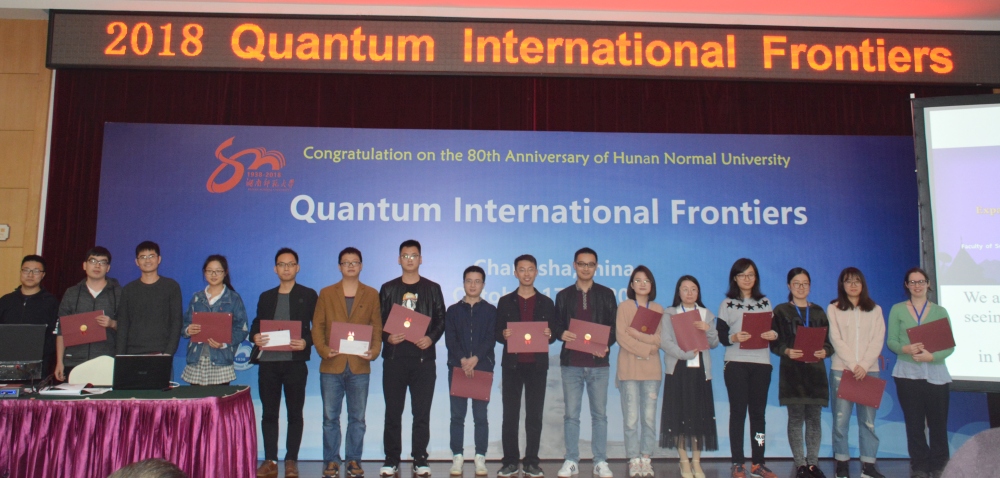
Click on photo for a larger version.
2018 Prize winners (left to right): Yanjun Liu 刘彦军, Yi Ren 任裔, Kailei Wang 王凯雷, Chengjie Fu 付成杰, Zhou Cao 曹洲, Liang Zhang 张良, Shan Liu 刘赡, Xiaolong Li 李小龙, Denggao Lai 赖登高, Xiaobao Liu 刘小宝, Yafeng Jiao 焦亚峰, Zhen Li 李振, Tian Tian 田恬, Jiahui Li 李佳慧, Mingzhu Sheng 盛明珠, Hongli Zhang 张宏丽, Yanting Xu 徐妍婷, Freda Jean Mwasha.
Abstract submission
NOTE: abstract submission deadline is September 20 2018!
Please download the Abstract Template (.docx format), complete the form, then email it to qifteam@quantum-int.org.Program
Most recent update 2018/10/12 18:15 UTC+8
Depending on the size of your screen, the program below may appear with horizontal or vertical scroll bars.
Conference Program (PDF)
International Scientific Committee
- Angela K. Wilson (USA)
- Mark S. Gordon (USA)
- Piotr Piecuch (USA)
- Alia Tadjer (Bulgaria)
- Sergei Manzhos (Singapore)
- J. Vincent Ortiz (USA)
- Erkki Brändas (Sweden)
- Samantha Jenkins (P.R. China)
- Steven R. Kirk (P.R. China)
- Yan (Alexander) Wang (Canada)
- Yasuteru Shigeta (Japan)
- Chao-Ping Hsu (Taiwan, China)
- Frank Harris (USA)
- Chang-Pu Sun (Chinese Academy of Sciences)
- Xingao Gong (Chinese Academy of Sciences)
- Ronggen Cai (Chinese Academy of Sciences)
- Wenjian Liu (P.R. China)
- Martin Quack (Switzerland)
- Anna Krylov (USA)
- Martin J. Paterson (UK)
- Malgorzata Biczysko (P.R. China)
- Sir David Clary (UK)
- Wei Ren (P.R. China)
- Jianxin Song (P.R. China)
- Jian Liu (P.R. China)
- Nawee Kungwan (Thailand)
- Sourav Pal (India)
Local Organizing Committee
- Samantha Jenkins (Changsha)
- Steven R. Kirk (Changsha)
- Jianxin Song(Changsha)
- Gang Ouyang(Changsha)
- Xianhui Zhong(Changsha)
- Tianlu Xu (Changsha)
- Dongsheng Tang(Changsha)
Honorary Committee
- Le-Man Kuang (匡乐满) (P.R. China)
- Gang Ouyang (P.R. China)
- Akitomo Tachibana (Japan)
- Jeffrey Reimers (P.R. China/Australia)
- Marco A.C. Nascimento (Brazil)
- Mark Eberhart (USA)
- Cherif Matta (Canada)
- Paul W. Ayers (Canada)
- Philip Hoggan (France)
- David Wales (UK)
- Tucker Carrington (Canada)
- Weitao Yang (USA)
- Mike Robb (UK)
- Markus Reiher (Switzerland)
- Fenglong Gu (P.R. China)
- Debashis Mukherjee (India)
- Wei Wu (P.R. China)
- Kersti Hermansson (Sweden)
- Shuhua Li (P.R. China)
Registration
Conference Photos
Travel
PLEASE NOTE: We intend to arrange for delegates to be met at railway stations and the airport, and accompanied to these travel hubs when leaving Changsha. Please make sure that you have sent your arrival and departure details to Professor Jenkins.
Travel to China
Visas:
A VISITOR visa is strongly recommended. Visa requirements can be checked on sites like the SKYTEAM Visa, Passport & Health Requirements page, which accesses the IATA TIMATIC database used by airlines and travel agents. If you require an invitation letter, please contact Professor Samantha Jenkins at the email address given at the top of this page.
Additional contact details for visa application purposes are:
Xu Tianlyu,
College of Chemistry and Chemical Engineering,
Hunan Normal University, 36 Lushan Lu, Yuelu Qu,
410081 Changsha, Hunan, P.R. China.
Phone: +86 180 7316 9990
Email: xutl@hunnu.edu.cn
Yongxing Zou,
College of Physics and Information Science,
Key Laboratory of Low-Dimensional Quantum Structures and Quantum Control of Ministry of Education,
Synergetic Innovation Center for Quantum Effects and Applications (SICQEA),
Hunan Normal University, Changsha 410081, China.
Phone: +86 13574812039
Prof. Samantha Jenkins,
College of Chemistry and Chemical Engineering,
Hunan Normal University, 36 Lushan Lu, Yuelu Qu,
410081 Changsha, Hunan, P.R. China.
Phone: +86 15111468042
Travel within China
By air
Incoming flights arrive at Changsha HuangHua international airport (CSX). Options for travel into the city include:
- Maglev train: There is a maglev train service linking the airport to the Changsha South (ChangShaNan) railway station, from which other options are available (metro, etc.)
- Shuttle bus: A shuttle service (for details, see the Whats's New in Changsha website) runs regularly from the airport to the Civil Aviation Hotel, close to the central train station in the center of Changsha. From there, available options are buses (there is a bus station beside the central train station), metro (line 2) or taxi.
By rail
Changsha is on the main Wuhan-Guangzhou high-speed train (gaotie)line (the high-speed train station is Changsha South (ChangShaNan) ). Train tickets can be bought:
- At a high-speed rail station in another city
Tickets for the high-speed 'G' trains (gaotie) or slightly slower 'D' trains can be bought at ticket counters at stations (stations in some of the biggest Chinese cities may have an English-speaking ticket counter).
- From Beijing, high-speed trains to Changsha operate from the Beijing West station
- From Shanghai, high-speed trains operate from Shanghai Hongqiao Station (near Shanghai Hongqiao [SHA] airport, in the east of the city). A lot of international flights to Shanghai land in Shanghai Pudong airport [PVG] (west of the city) which is all the way on the other side of the city. There is a metro line that joins the two airports but anticipate at least two hours to get from one side of Shanghai to the other by this route.
- From Guangzhou, high-speed trains operate from Guangzhou South Station.
- Online (web sites or phone apps)
A number of websites sell high-speed train tickets online. For example, to book high-speed trains on the online travel agent CTrip, where trains can be securely booked and paid for using, for example, Western credit cards, first select 'Trains', then enter the desired starting point and destination and date, then select the 'High-speed trains' filter to check availability. Once successfully ordered and confirmed, there are several ways to pick up the tickets :
- Ask for the tickets to be mailed to you (ask, e.g. CTrip about this),
- Ask for the tickets to be mailed to a hotel in, e.g. Beijing or Shanghai, where you may be stopping over before travelling on to Changsha (after checking that the hotel can keep the tickets and give them to you on your arrival there),
- Ask CTrip for E-tickets, then take the E-ticket codes to the ticket collection office in the relevant high-speed train station. This can be done by presenting the ticket reference number, together with a passport for ID purposes, at specially-labelled ticket counters (these counters have the characters '护照', passport, written on them).
NOTE: Conventional (much slower) trains stop at Changsha Central Station, not Changsha South Station.
- At a high-speed rail station in another city
When you arrive by rail in Changsha, there are several options to travel to the central part of the city and the conference venue. One of these is the metro system. Changsha South Railway station is on the city metro line 2 (see map).
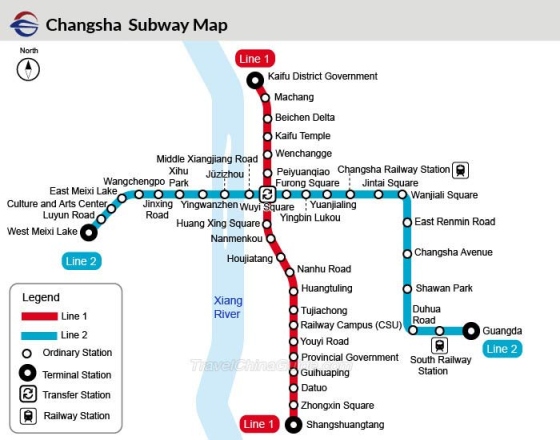
- By metro: The venue, the Changsha South high-speed railway (GaoTie) station, the central city railway station and the main metro interchange can all be reached using Changsha metro line 2. The closest metro stop to the venue is Yingwanzhen.Leave the metro station using exit 3 (see map above) and walk a short distance to the venue.
- By taxi (). Taxi fares are approximately 1.8 RMB/km.
Conference Venue and Accomodation
QI-2018 will be located in the Fenglin Hotel, 43 Fenglin 1st Road (Fenglin Yi Lu), Yuelu District, Changsha 410006 (湖南省长沙市岳麓区枫林一路43号 邮政编码: 410006)
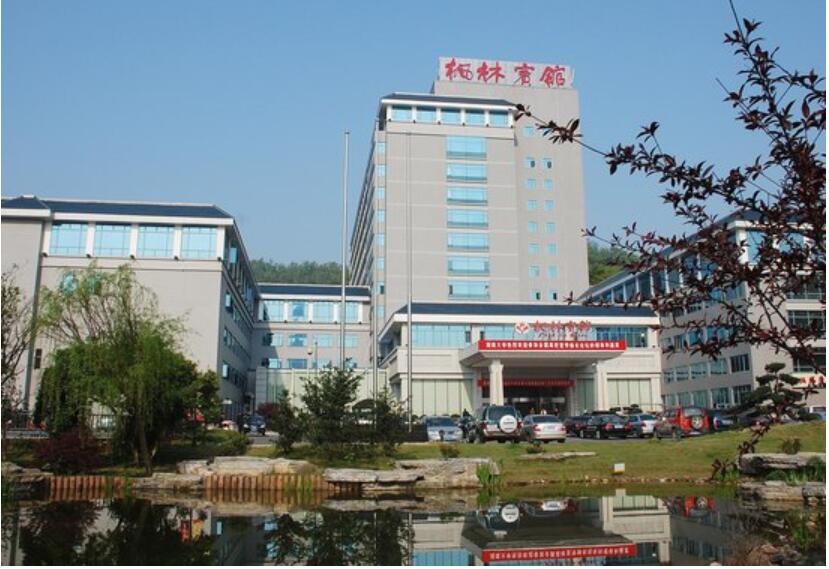 Venue: Fenglin Hotel.
Venue: Fenglin Hotel.
The hotel is located opposite a shopping mall (Tongcheng Plaza), with well-known chains such as Starbucks, McDonalds, KFC, Pizza Hut and Watsons: there is also a supermarket and some smaller food outlets in the basement of this mall.
Other Sources of Information
- WikiVoyage - China
- WikiVoyage - Hunan Province
- What's New in Changsha - Changsha News, events and information in English This is an excellent general (and travel) guide to Changsha.
- Travel China Guide: Hunan Travel Guide
- Wikipedia article on Zhangjiajie
- Zhangjiajie Hehua International Airport (DYG)
- Zhangjiajie Transportation
Info:
Helpers: Conference helpers may be found at the conference itself, the airport and the high-speed railway station.
If you are not a Chinese speaker, you may find it useful to download and install a translator app on a portable device (Android/iOS, etc.), e.g. Microsoft Translator, before entering China. Most translator apps allow you to download and install 'offline translation dictionaries' - these are highly recommended and very useful, because they will work even without a phone data connection or Internet connection. Some of these apps have text recognition features, allowing you to point your device camera at some text and get an instant translation. Others also have voice recognition features. It is generally also a good idea to install a Chinese keyboard (input method IME) on your device alongside your existing language keyboard: this could make it easier for Chinese speakers to type any replies to queries or information into the translator app.
In any files used for presentations, please make sure the files are saved with embedded fonts. This helps to reduce problems associated with required mathematical/non-English characters not being present on the computer used for the presentation.
Accommodation:
Changsha Accomodation (Venue)
We have booked a block of rooms in the venue hotel (Fenglin Hotel, website). Delegates can pay on arrival unless otherwise arranged. The hotel accepts Visa and MasterCard credit cards.
All the lectures and the banquet will also take place at this hotel.
We will reserve two room types (both types have ensuite WC and shower) :
- ROOM OPTION A: 488RMB/day (includes breakfast). Floors 11 and 12, 33 sq.m. Desk + chairs + bath tub [There are 9 such king-bed rooms, the others are twin-bed (bed width 1.2m)].
- ROOM OPTION B: 348RMB/day (includes breakfast). Floors 1-4, 32 sq.m, chairs [There are 9 such king-bed rooms, the others are twin-bed (bed width 1.2m)].
Breakfast is included with the room booking, and is served at the breakfast restaurant on the ground floor of the Fenglin Hotel. Lunch/Dinner buffet will be provided free of charge (your conference bag will contain the necessary tickets) and will be served in the ballroom on the second floor.
Please send ALL of the following information by email to Tianlü xutl@hunnu.edu.cn:
- Your full name *exactly* as it appears on your passport
- Your Passport number
- Your flight number or train number when you have booked
- Your arrival date
- Your departure date
- Your choice of room; OPTION A or OPTION B.
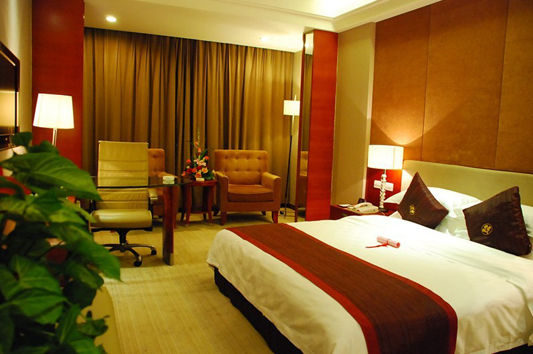 Example Option A room
Example Option A room
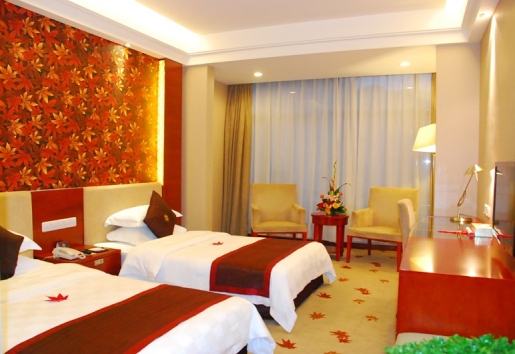 Example Option B room
Example Option B room
Changsha
Below is a map of the important locations for QI Frontiers 2018 in Changsha.
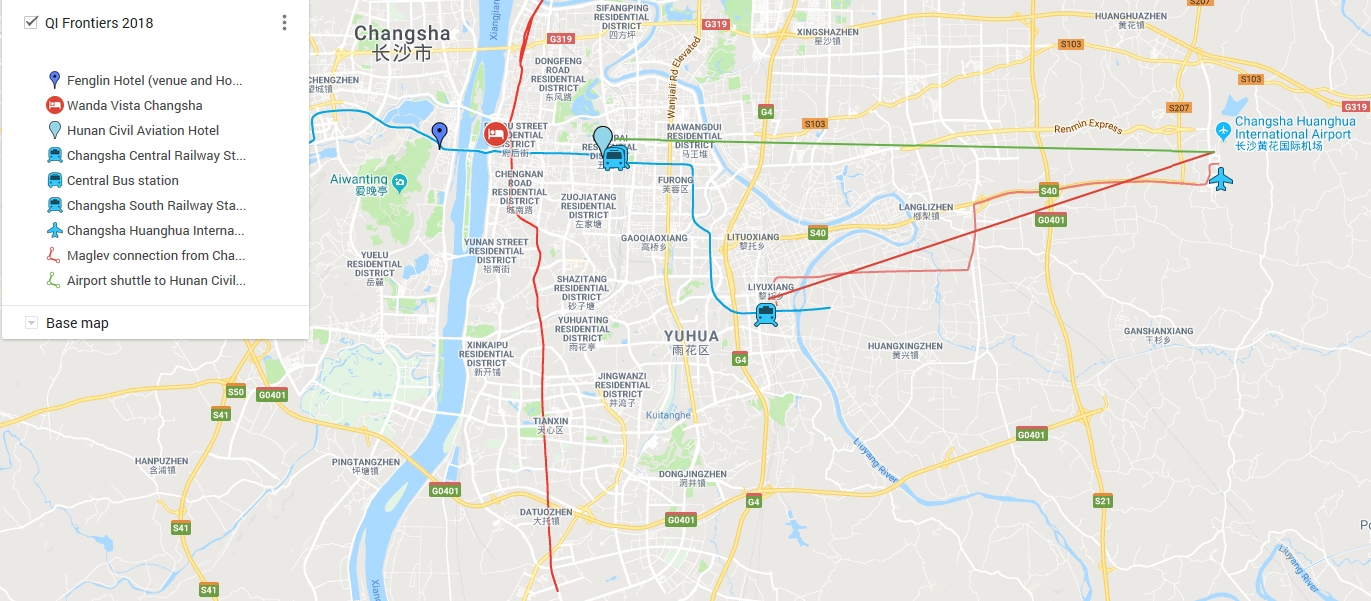
Attractions in Changsha
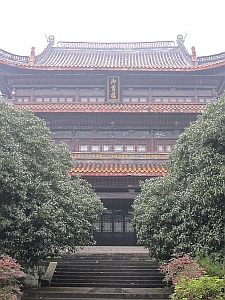
Yuelu Mountain and Yuelu Academy
Explore the trails, paths and temples of this popular location, or visit Yuelu Academy, one of the four ancient seats of learning in China. Further information in English (1,2,3,4) and in Chinese here.
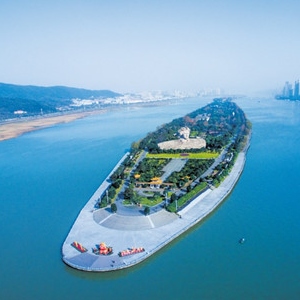
Juzhizhou (Orange Island)
Walk or go one metro stop to Orange Island, with ornamental gardens, pavilions and the Young Mao Zedong statue.
Activities
On October 22 and 23 there will be a trip to the World Heritage site at Zhangjiajie. Participation in this trip is entirely voluntary. Let us know ASAP if you want to take part, and which of the two options for the tour that you prefer.
There are two different versions of the trip: please see the information in the PDF files for prices and event details.
Click on any of the pictures below to see a larger version.
Zhangjiajie Traditional Culture Show
Zhangjiajie Accomodation - Zhangjiajie Pullman Hotel
Available trip choices - click on PDF files for full details
If you want to make a booking for one of these trips, please contact Xu Tianlü xutl@hunnu.edu.cn AS SOON AS POSSIBLE.
